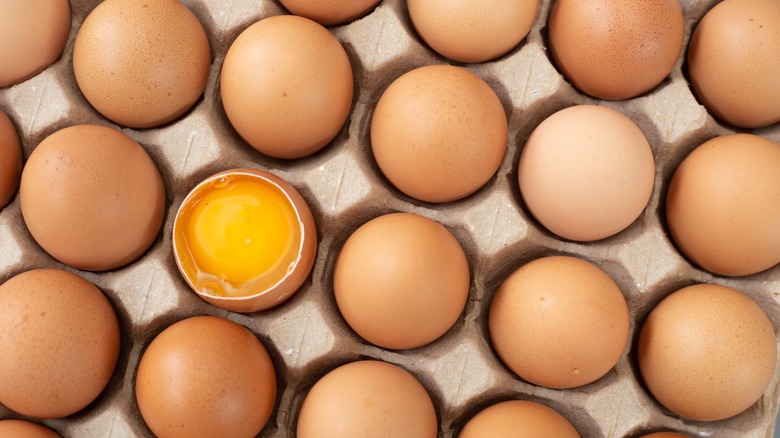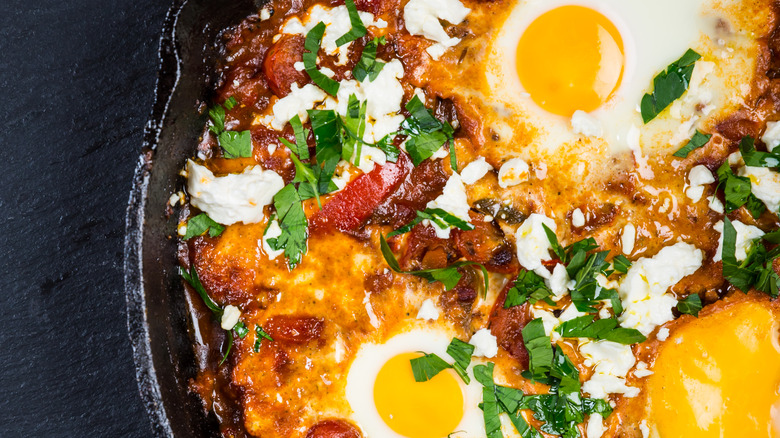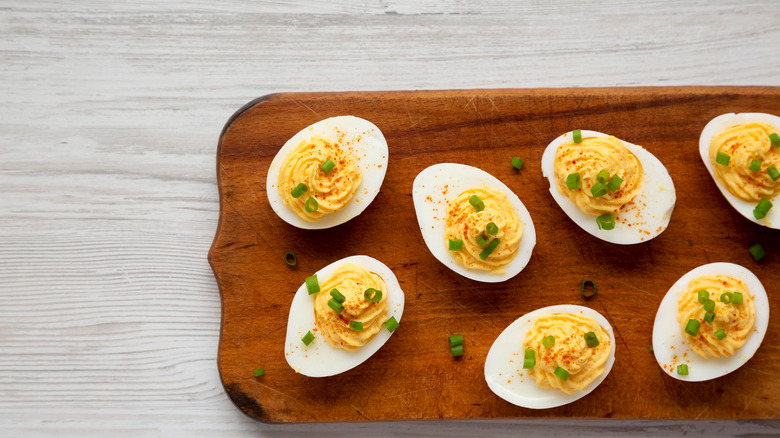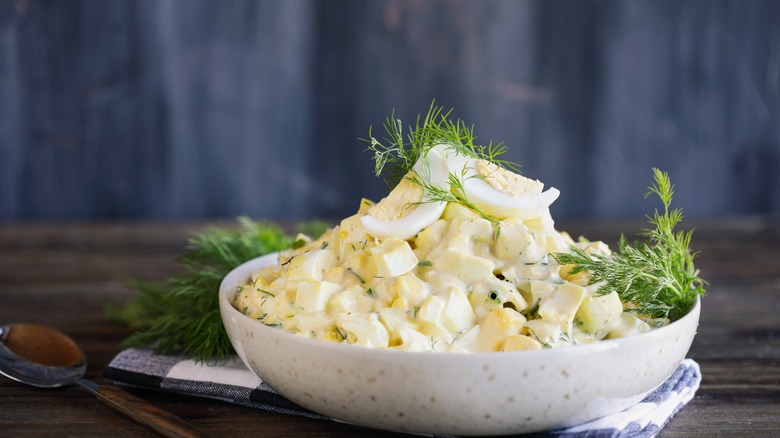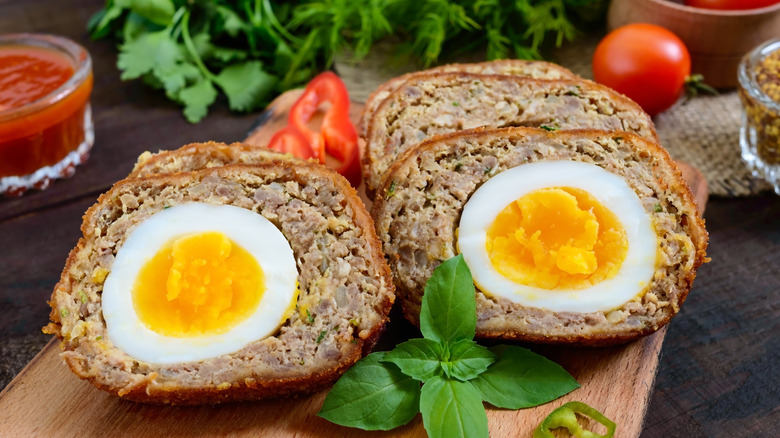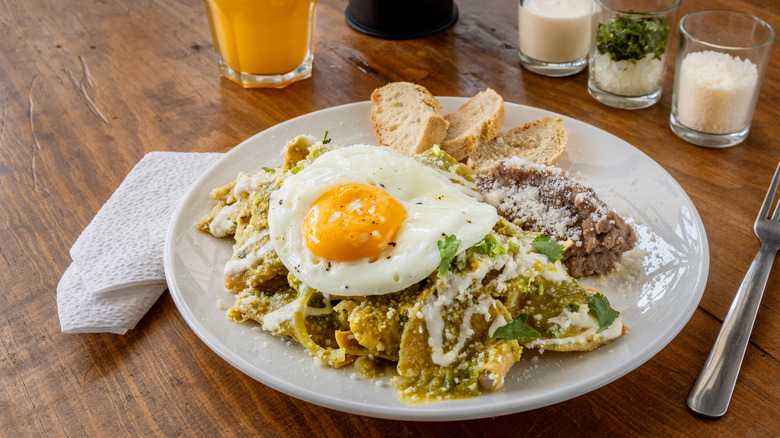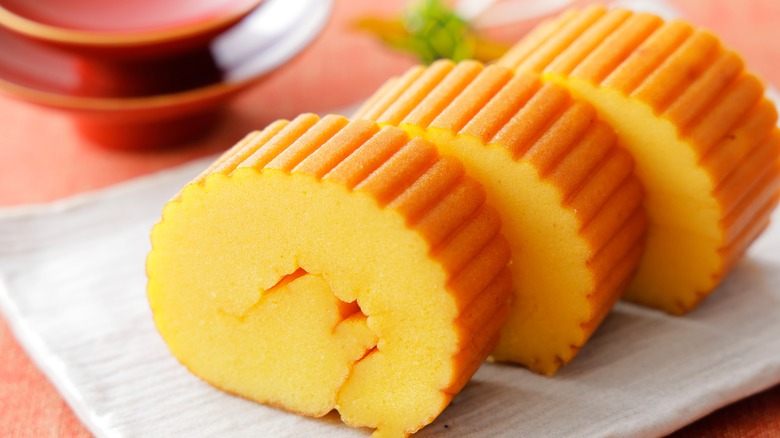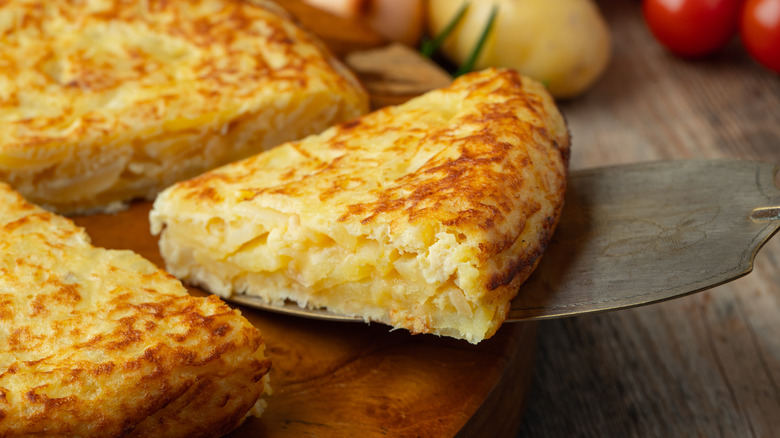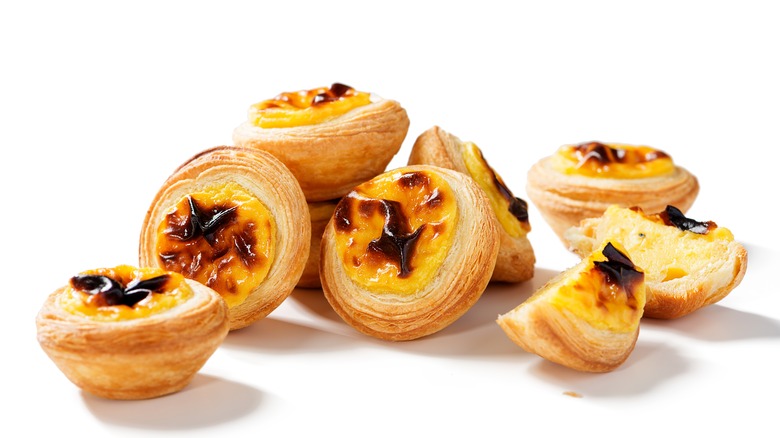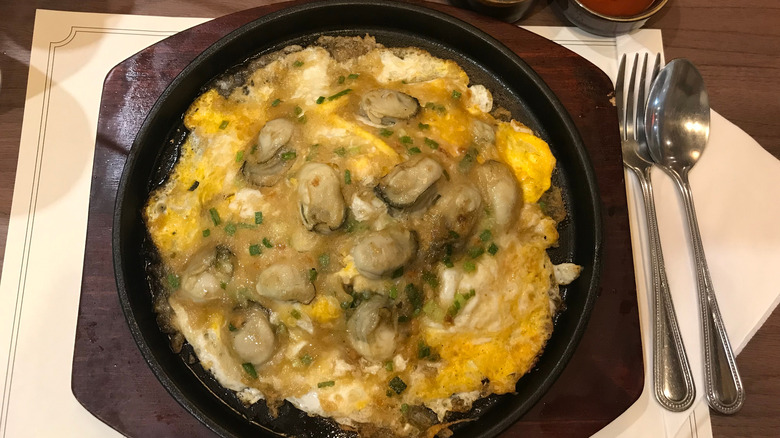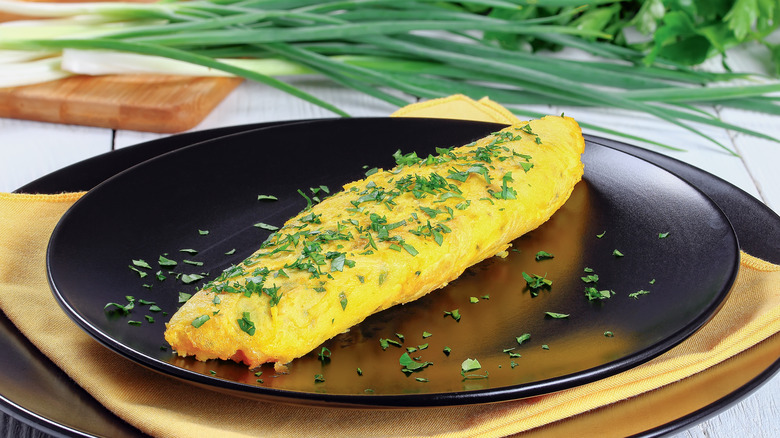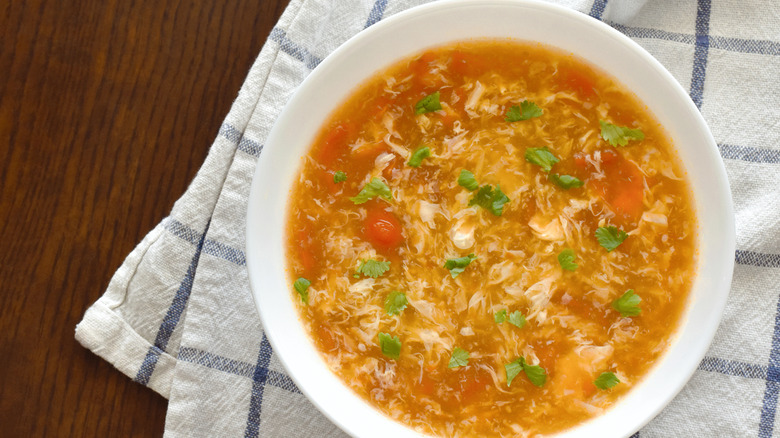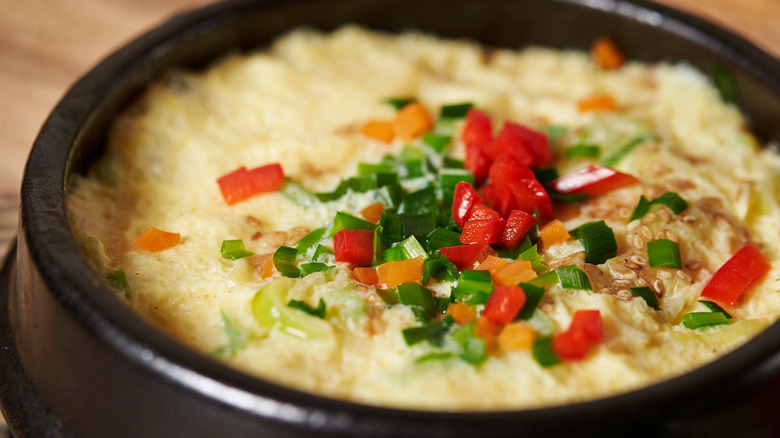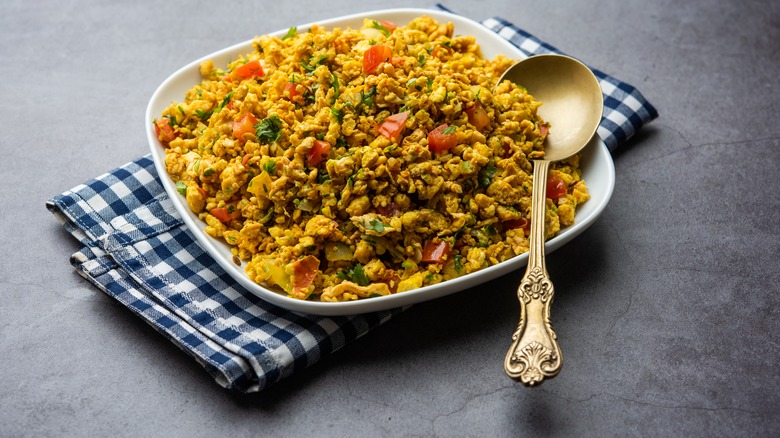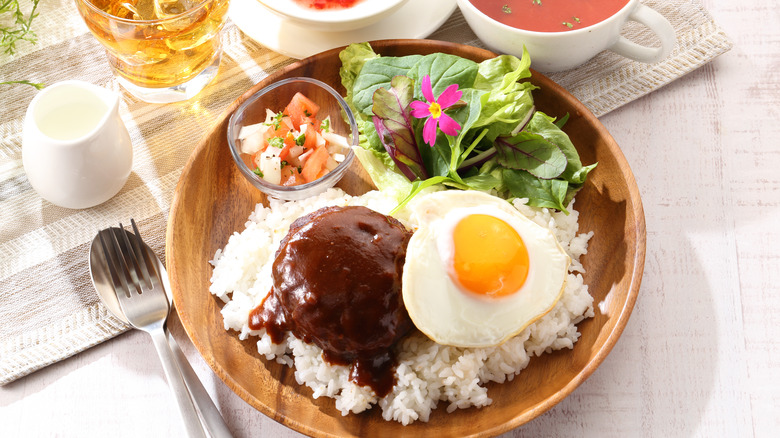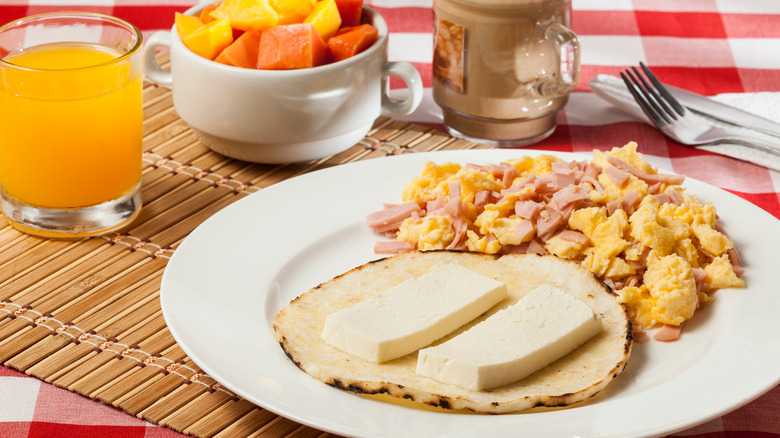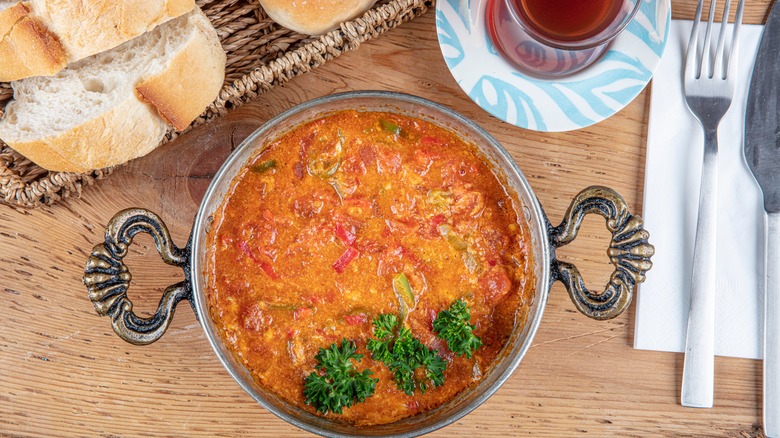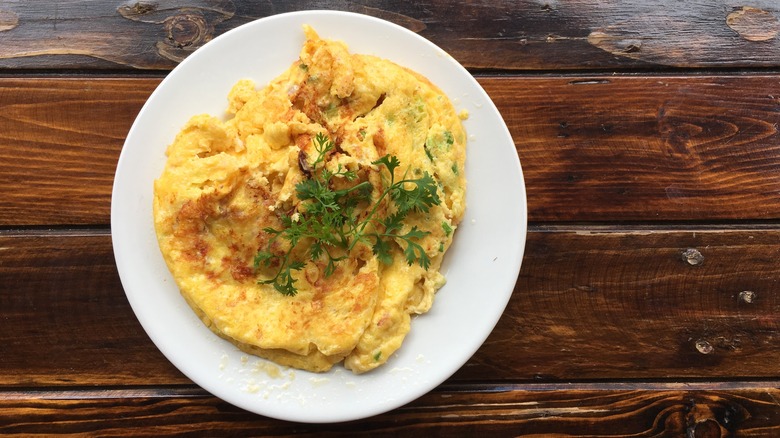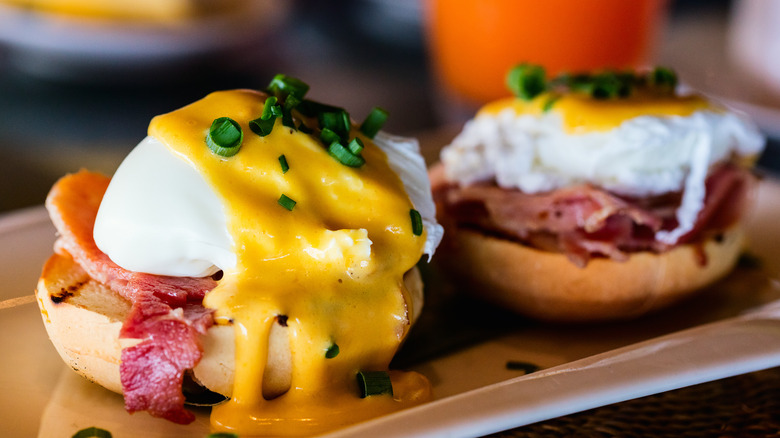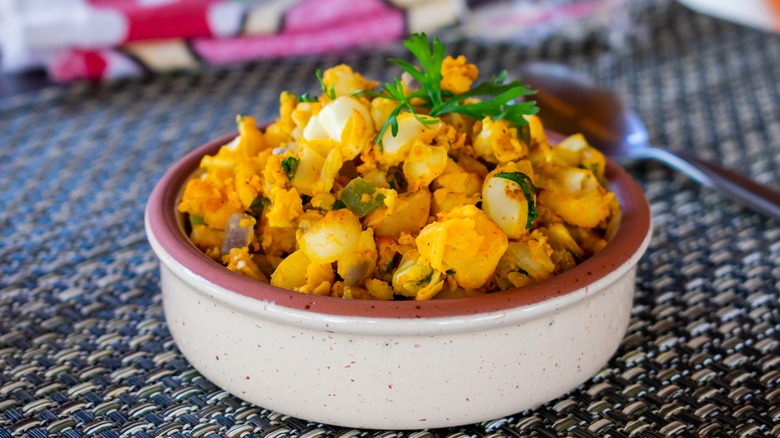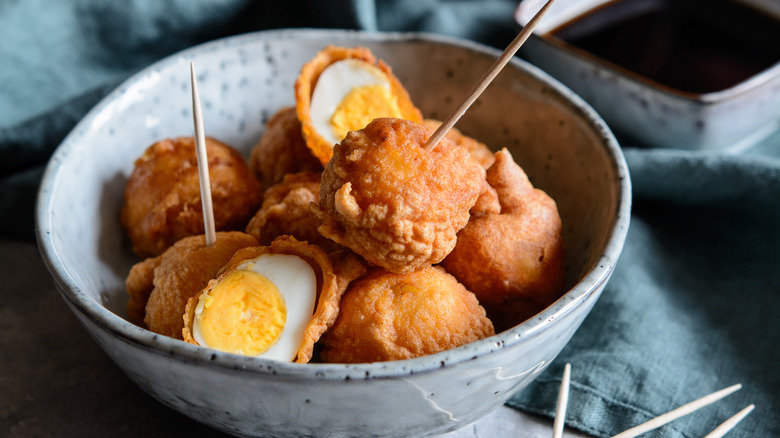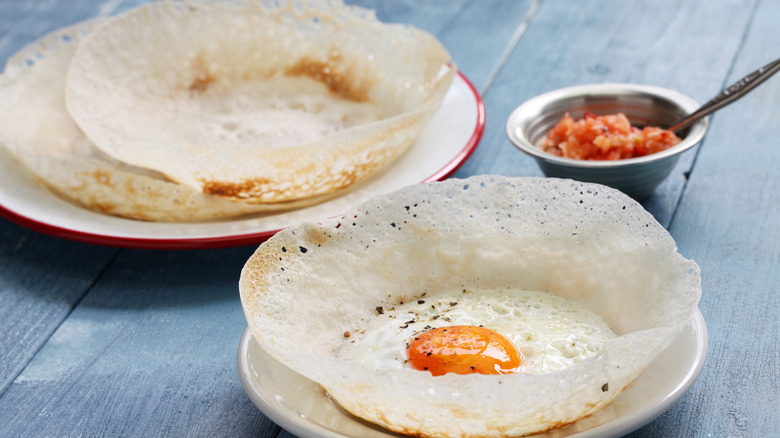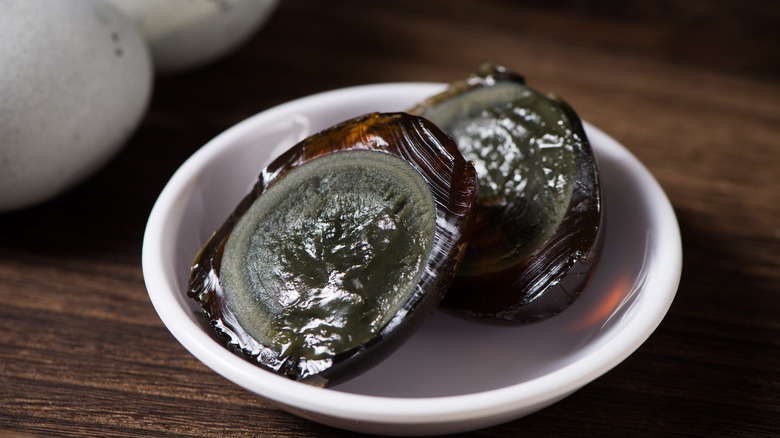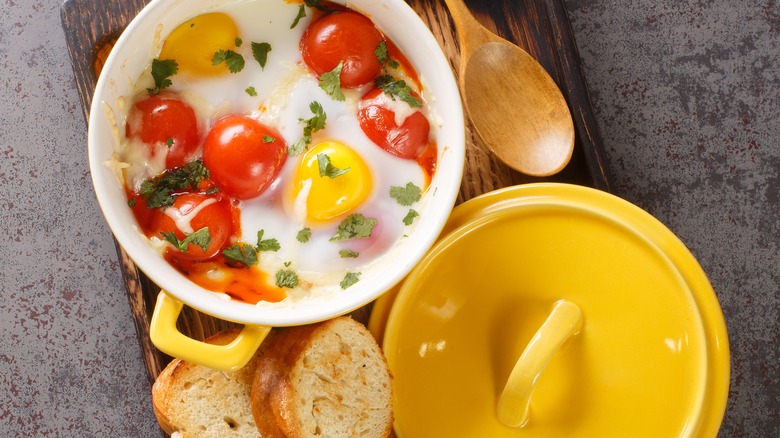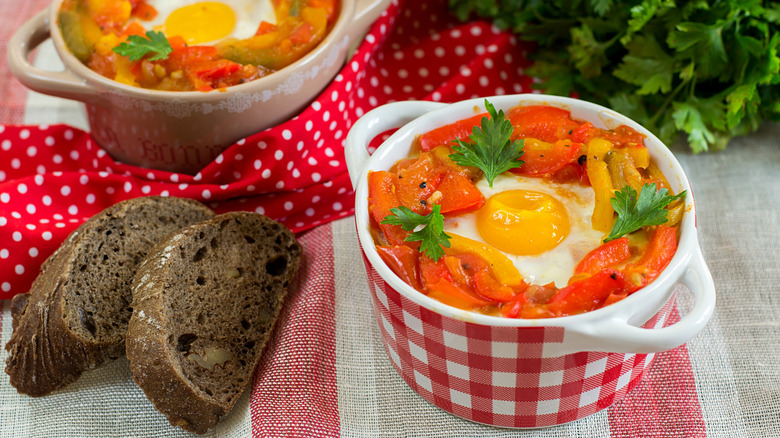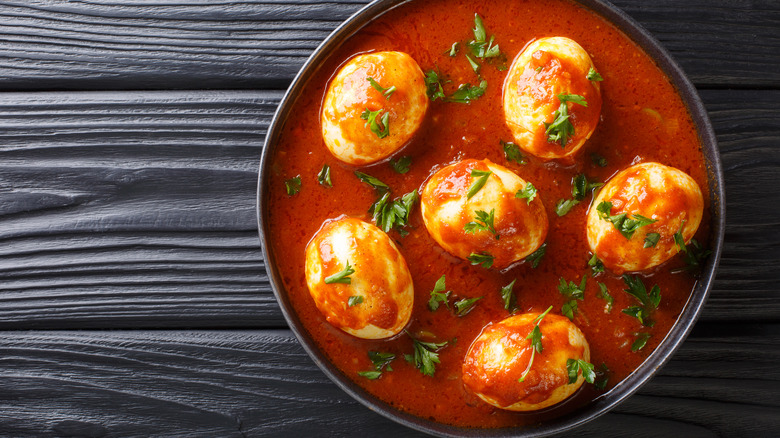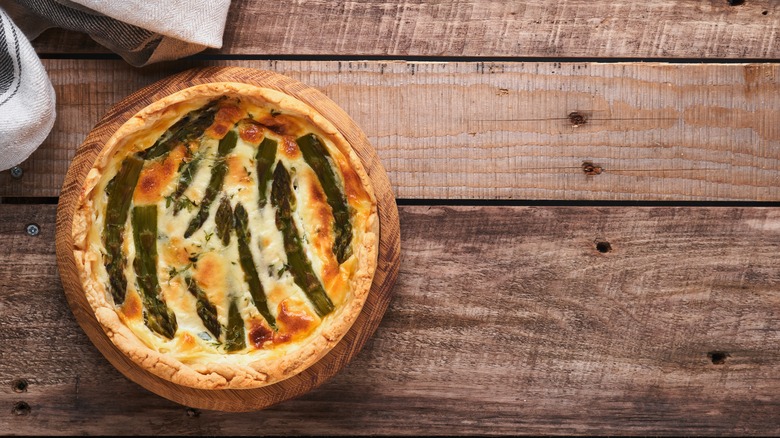26 Ways Eggs Are Eaten Around The World
Eggs are a nutritious breakfast option filled with Vitamin D, protein, and fat. For centuries, societies have flocked to eating eggs because of the abundance, low cost, and versatility of predominantly chicken eggs, but also other types of eggs from ducks and quails.
Although most Americans just know eggs from being asked "scrambled or over easy?" at a diner, it is important to note that there is a whole world of possibilities when it comes to preparing eggs. Cultures around the world have different preparation methods as well as ways of immersing other ingredients and flavors with the humble egg. This makes the egg something far more than just a boring scramble on a plate — it transforms into a truly spectacular culinary asset.
Here are some of the ways eggs are prepared in cultures around the world. And who knows, you may never go back to eating the same boring scrambled eggs ever again.
Shakshuka (Israel)
Shakshuka is an Israeli egg dish typically made and served in a cast iron pan. Although shakshuka has roots in Northern Africa, it has been since claimed as a staple breakfast food in Israel. This egg dish combines the flavors of cumin, bell peppers, onion, paprika, sumac, cinnamon, and coriander with eggs poached in roasted tomato sauce. The egg yolks remain runny while the whites are immersed in the sauce's acidity and spiciness. Shakshuka can be served with breakfast meats like sausage and bacon (although the dish itself is vegetarian), as well as pieces of crusty bread for wiping up the sauce.
Deviled eggs (Italy)
Believe it or not, you can credit these tailgate-approved eggs to the Italians. Deviled eggs are made with the yolks of hard-boiled eggs. After the yolks have been pulverized, mayonnaise and mustard are added as binders. You can also add hot sauce, flavored mustard, or vinegar to the yolk to adjust the flavor. Then, the yolk is spiced with ingredients like dill, coriander, or cracked pepper before being spooned or piped back into the egg white shell. Deviled eggs are popular at sporting events, dinner parties, or as appetizers for special occasions.
Egg salad (United States)
Egg salad bears some similarities to deviled eggs. But instead of just the yolk being pulverized with other ingredients, the entire egg is mixed with ingredients like mayonnaise, mustard, and spices. Common other ingredients that appear in egg salad recipes include apple cider vinegar, Dijon mustard, celery pieces, or dill. The egg salad can be served cold on top of a salad or inside of a sandwich (we recommend pairing a creamy egg salad with crunchy iceberg lettuce, tomatoes, or a vegetable garnish for an added textural element).
Scotch eggs (United Kingdom)
Scotch eggs are an anomaly. These hard-boiled eggs are typically served in pubs in the United Kingdom, though scotch eggs have mysterious origins that can be traced to different parts of the world. Generally, they're wrapped in a pork sausage and breadcrumb coating and can be either deep-fried or baked. These eggs are usually served with a side of marinara sauce or ranch dressing, making them akin to American mozzarella sticks. You may also see Scotch eggs with a flare on the original recipe; some chefs top the Scotch eggs with bacon and cheese to make a filling breakfast dish.
Chilaquiles (Mexico)
Chilaquiles are a Mexican breakfast dish that has percolated into some American breakfast joints. Chilaquiles are essentially breakfast nachos — served on a base of tortilla chips and piled high with Mexican crema, roasted tomatillos and peppers, salsa, cotija cheese, avocado, radish, and cilantro. Chilaquiles also wouldn't be complete without a fried egg on top, which oozes over the tortilla chips once the yolk is sliced open. You can also make chilaquiles with scrambled eggs, but there's something about a soft yolk that just makes this egg dish unique.
Datemaki (Japan)
Datemaki is an unusually shaped egg omelette found in Japan. It is a sweet, fluffy, baked rolled omelette served on New Year's. The omelette gets its flavor from fish cake, soy sauce, and sweet seasonings like honey and mirin. The fish cake, also known as hanpen, is made from grated Japanese yam, Alaskan pollock, and kombu dashi. Once the ingredients are added to a blender, the omelette is strained, baked, and rolled into a swirl on a bamboo mat. Once the Datemaki has cooled, it can be sliced into small rounds for serving.
Spanish tortilla (Spain)
Spanish tortillas, also known as the tortilla espanola, is a frittata-like egg dish with potatoes and onions. You'll find Spanish tortillas on most tapas menus paired with Spanish bubbly cava. You can use a variety of potatoes to flavor your Spanish tortillas, but we recommend using slivers of purple tubers for a bright pop of color.
If you plan on making Spanish tortillas at home, you should use a sturdy non-stick skillet so that your tortilla slides out of the dish with ease. After all, these aren't scrambled eggs.
Portuguese egg tarts (Portugal)
The world of global egg dishes doesn't just have to be savory. Portuguese egg tarts are made with a shell of puff pastry filled with a soft, decadent egg custard. As noted by Pearl River Mart, the creation of this sweet eggy dessert stems from monks at the Jerónimos Monastery in the 1200s. The monks, who had a working knowledge of French pastry from the time spent in the region, used the leftover yolks from when egg whites were separated and used to starch clothing.
Oyster egg omlette (Taiwan)
O ah jian was originally a Chinese delicacy but has since evolved into Taiwan's street food industry. Otherwise known as a Taiwanese oyster omelette, this egg dish is made with celery leaves, freshly shucked oysters, and eggs. The oyster omelette is served with a sweet-and-sour ketchup sauce made from ketchup, rice vinegar, sugar, cornstarch, and soy sauce. While the celery leaves are traditional for the dish, other popular veggie additions include chopped baby bok choi and Swiss chard.
French omelette (France)
The French are supreme omelette makers, so it isn't a surprise that this country's omelettes come out perfectly soft and fluffy every time. But you too can master the technique of a Jacques Pepin and Julia Child-approved French omelette in a matter of minutes. This omelette breaks ingredients and technique down to the bare bones, calling for only eggs and fat to prevent sticking. Unlike other omelettes that are roughly flipped and moved in the pan, using gentle hands to roll the omelette across is critical to preventing French scrambled eggs.
Egg drop soup (China)
Egg drop soup is a Chinese soup recipe made with a few simple ingredients like chicken broth, scallions, and soy sauce. This soup is quick to cook and gets its name from when eggs are dropped and swirled in the soup, forming characteristic eggy strands. To prevent pulverizing the egg in the soup, the soup is mixed in a whirlpool-like motion when the egg is dropped in. Egg drop soup is commonly served in American Chinese restaurants, some of which also refer to it as egg flower soup.
Gyeranjjim (Korea)
Gyeranjjim is a Korean steamed egg dish commonly eaten as a side for breakfast, lunch, and dinner. The eggs are traditionally flavored with freshly chopped vegetables, anchovy paste, or vegetable broth. The eggs get a signature shape from constant beating as well as steaming in a ceramic dish (known a ttukbaegi) in the oven. After the eggs are cooked, the Gyeranjjim is garnished with sesame seeds or chopped scallions for additional color and flavor.
Egg bhurji (India)
Indian food is known for its pungent flavors and delicious curries. Egg bhurji, otherwise known as anda bhurji ("anda" is Hindi for egg), is an Indian spiced egg scramble with turmeric, cumin seeds, and vegetables. Some variations use garam masala, but a homemade spice mix is more typical. Egg bhurji is served with roti, rice, or bread or used as a stuffing for sandwiches or kathi rolls; the exact use of the dish is dependent on the region of India it is prepared in.
Loco moco (Hawaii)
A loco moco is a dish native to the Hawaiian islands. It's one of the most popular dishes in Hawaii and dates back to the islands' plantation days. It combines a base of white rice, burger patty, fried egg, and beef gravy. The loco moco's egg is left runny to ensure that it flavors all parts of the dish. If you want to ensure an equal ratio of ingredients on the plate, you can use a ring-shaped mold to form the rice, cook your beef patty, and fry the egg, but it isn't entirely necessary.
Perico (Columbia and Venezuela)
Perico is a scrambled egg dish common in Colombia and Venezuela that roughly translates to "parakeet" in Spanish (per Cambridge Dictionary). It is believed that the dish got its name from the colorful peppers, eggs, and onions that resemble a parakeet's feathers, but even this is disputed. Unlike other egg dishes, perico usually includes cooked tomato for added flavor, as well as scallions instead of regular yellow onions for a pop of flavor and texture. Perico is served with other breakfast foods like arepas and beans, as well as with a garnish of cojita cheese.
Menemen (Turkey)
Menemen is a Turkish egg scramble made with tomatoes, peppers, and onions. It draws some similarities to perico, but adds a blend of Turkish spice into the mix. One of the key ingredients that makes menemen unique is Aleppo pepper. This pepper has the same heat as an ancho chili but with the undertones of cumin, vinegar, and salt. This spice boosts the flavor of the egg and makes this dish more earthy than a boring plate of scrambled eggs.
Khai Jaio (Thailand)
Khai Jaio is a Thai omelette made with a soft plushy inside and crisp exterior. In Thai culture, the Khai Jaio is added on top of rice to complete a meal or to take the edge off other spicy food in the meal. This omelette is cooked over high heat oil in a shallow pan to develop a crispy exterior. The addition of rice flour can also help create more crisp edges. The Khai Jaio is flavored with fish sauce and vinegar, which makes this egg dish a little more savory.
Eggs Benedict (United States)
Eggs Benedict is a unique breakfast dish in America made with poached eggs, hollandaise, Canadian bacon, and an English muffin. The first step in making a traditional eggs Benedict is to separate the butter solids from the liquids (a process called clarifying) and brush the English muffins with the butter after poaching. The hollandaise is made from egg yolks, lemon juice, and salt cooked over low heat with a bit of clarified butter. The flavor of this brunch dish is unctuous, decadent, and just screaming to be paired with a mimosa.
Mote Pillo (Ecuador)
Mote pillo is native to the South American country of Ecuador where it is usually eaten for breakfast or brunch. The robustness of this recipe stems from the inclusion of hominy, which are dried corn kernels similar to the consistency of grits. The eggs are scrambled with the hominy and seasoned with cumin, leeks, and garlic powder. Cheese can be sprinkled on top of mote pillo for more flavor — we recommend using cotija cheese.
Kwek kewk (Philippines)
Kwek Kewk is a Filipino street food dish made from not chicken eggs, but quail eggs. These eggs are hard boiled before being rolled in a cornstarch batter flavored with annatto — a bright orange food coloring, per Healthline. The kwek kwek are then fried until golden brown and served with a vinegar or a fish-sauce dipping sauce. Filipino street food vendors will usually serve kwek kwek along with squid balls, fish balls, and chicken balls at pop-up vendors.
Egg hopper (Sri Lanka)
In Sri Lanka, egg hopper is made like a savory crepe with a fried egg at the bottom. It's almost like an eggy version of a bread bowl. The wafer-thin layers on the outside of the pan are made from a mix of yeasted rice flour, sugar, and coconut milk. These ingredients add an element of lightness and sweetness to the dish. The egg is added after the crepe is cooked as to leave the yolk soft and decadent.
Century egg (China)
A century yolk just might be the most unique way people around the world eat eggs. The egg, which Masterclass notes is native to China and Taiwan, is made by preserving the egg for weeks to months in a mixture of clay, ash, and lime. As the egg ages, the outer texture will turn a translucent green while the yolk turns the color of concrete. When eaten, these eggs are salty, smooth, and creamy (if you can stomach eating a green egg, of course).
Oeufs Cocoette (France)
Oeufs Cocoette are also called shirred eggs. Like many egg dishes, they rose in popularity because they were inexpensive and filling. The flat-bottomed cooking dishes are called shirrers, and the French use this dish to bake the eggs in a water bath. The eggs are cracked into a small buttered ramekin and baked until the egg white becomes slightly solid with a runny yolk.
This egg dish is customizable based on the ingredients you have in your refrigerator. Add a sprinkle of goat cheese, a bit of shredded ham, or your favorite crisp vegetables.
Eggs piperade (Basque)
Eggs piperade is a Basque dish similar to mote pillo and perico. Like other egg preparation methods, this scrambled egg dish is flavored with onions, peppers, and tomatoes. But one of the pivotal ingredients in eggs piperade that separates it from other similar dishes is paprika. Paprika is a common spice in the Spanish region near the Basque islands, so it isn't unexpected to see the spice appear in eggs piperade. Using smoked paprika to flavor the eggs and the vegetables will provide an unexpected flair to this meal.
Egg curry (India)
Contrary to common belief, a curry is a combination of spices rather than just one specific type of spice. Egg curry can be adapted based on the region of India it is descended from. Dhaba egg curry, for example, is made with finely grated, chopped, or pureed onions and tomatoes. Then, a few hard-boiled eggs are fried in ghee in a pan until slightly blistered and spiced. Then, the onions, tomatoes, eggs, and curry spices (in this case bay leaf, cinnamon, cardamom, cumin, and cloves) are combined in a dish and simmered until warmed through.
Quiche (Germany)
Bet you didn't know that the Germans invented the quiche! Well, even that is disputed. Per Importico's Bakery Cafe, the first quiches were created in Germany during the Middle Ages. The region was, at the time, called Lothringen and was eventually renamed Lorraine. The original quiche Lorraine was made with an open pie filling of cream, eggs, and sliced bacon surrounded with bread dough. The bread dough eventually evolved into a puff pastry or shortcrust pie shell. The quiche further went on to include other vegetables, meat, and even shellfish.
